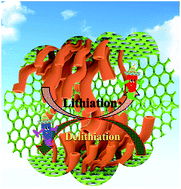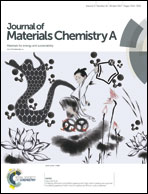Ultrahigh capacity and superior stability of three-dimensional porous graphene networks containing in situ grown carbon nanotube clusters as an anode material for lithium-ion batteries†
Abstract
Three-dimensional porous graphene networks containing in situ grown carbon nanotube clusters (CNTs@3DG) with a superior composited nanostructure have been fabricated in a one-step metal-catalyzed thermolysis. The unique self-assembled 3D porous structure exhibits a high surface area (1673 m2 g−1), a well-defined pore structure, as well as an excellent electronic conductivity. Inside the CNTs@3DG, abundant clusters of CNTs with an average size of 25 nm are in situ grown at the inner walls of porous graphene networks. The CNTs and graphene networks form a relatively stable architecture of 3D interconnected CNTs and graphene, which offers convenient channels for electron transport and lithium ion diffusion. This promising CNTs@3DG anode material reveals an ultrahigh reversible capacity of 1132 mA h g−1 and an advantageous retentive capacity of 1054 mA h g−1 after 200 cycles at 100 mA g−1. More significantly, excellent reversible capacities of 720 and 663 mA h g−1 and superior long-cycle-life capacity decays of 0.017 and 0.025% per cycle after 1000 cycles were obtained at large current densities of 1 and 2 A g−1, respectively. It also exhibits a remarkable rate performance, including large capacities of 459 and 383 mA h g−1 at 4 and 5 A g−1 current densities, respectively.



 Please wait while we load your content...
Please wait while we load your content...